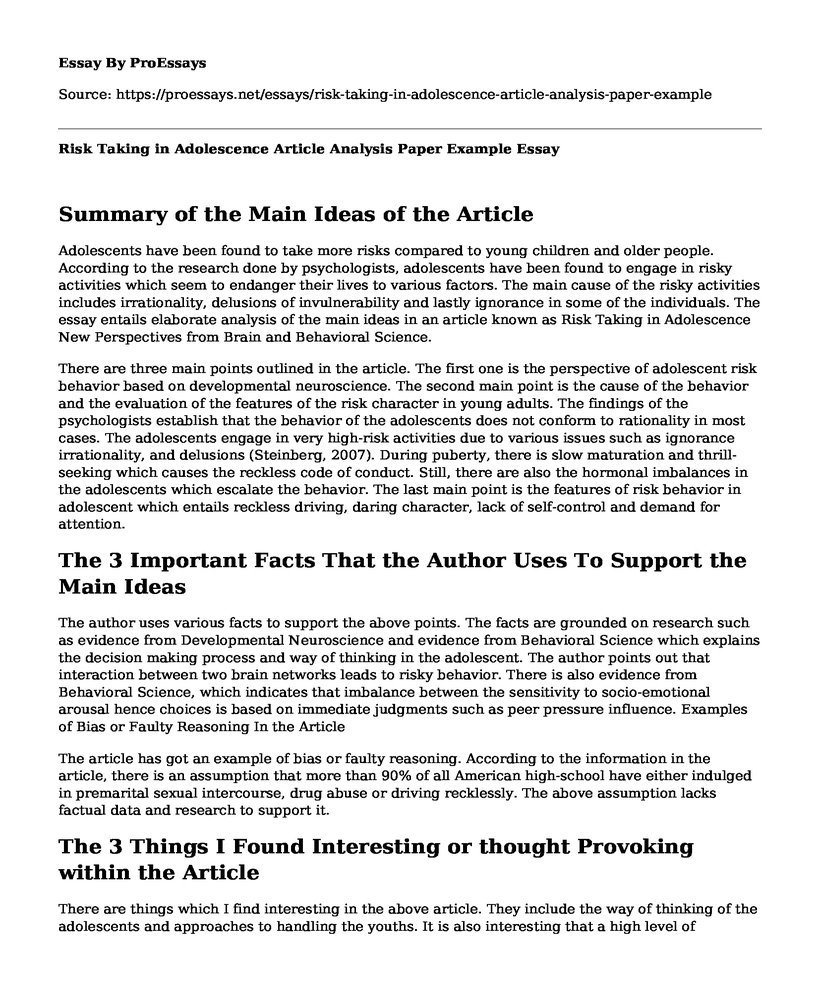Summary of the Main Ideas of the Article
Adolescents have been found to take more risks compared to young children and older people. According to the research done by psychologists, adolescents have been found to engage in risky activities which seem to endanger their lives to various factors. The main cause of the risky activities includes irrationality, delusions of invulnerability and lastly ignorance in some of the individuals. The essay entails elaborate analysis of the main ideas in an article known as Risk Taking in Adolescence New Perspectives from Brain and Behavioral Science.
There are three main points outlined in the article. The first one is the perspective of adolescent risk behavior based on developmental neuroscience. The second main point is the cause of the behavior and the evaluation of the features of the risk character in young adults. The findings of the psychologists establish that the behavior of the adolescents does not conform to rationality in most cases. The adolescents engage in very high-risk activities due to various issues such as ignorance irrationality, and delusions (Steinberg, 2007). During puberty, there is slow maturation and thrill-seeking which causes the reckless code of conduct. Still, there are also the hormonal imbalances in the adolescents which escalate the behavior. The last main point is the features of risk behavior in adolescent which entails reckless driving, daring character, lack of self-control and demand for attention.
The 3 Important Facts That the Author Uses To Support the Main Ideas
The author uses various facts to support the above points. The facts are grounded on research such as evidence from Developmental Neuroscience and evidence from Behavioral Science which explains the decision making process and way of thinking in the adolescent. The author points out that interaction between two brain networks leads to risky behavior. There is also evidence from Behavioral Science, which indicates that imbalance between the sensitivity to socio-emotional arousal hence choices is based on immediate judgments such as peer pressure influence. Examples of Bias or Faulty Reasoning In the Article
The article has got an example of bias or faulty reasoning. According to the information in the article, there is an assumption that more than 90% of all American high-school have either indulged in premarital sexual intercourse, drug abuse or driving recklessly. The above assumption lacks factual data and research to support it.
The 3 Things I Found Interesting or thought Provoking within the Article
There are things which I find interesting in the above article. They include the way of thinking of the adolescents and approaches to handling the youths. It is also interesting that a high level of imbalance between the sensitivity to socio-emotional arousal leads to a risky code of conduct. Still, the impact of peer pressure is fascinating, since most of the adolescents tend to claim to have free will in thinking. There is also a clear indication of the ways which can be used to master the causes of the reckless activities in the young adults and also the approaches which can be used to control the behavior.
The New Information and Three Facts That were Not in Textbook
The information which is new for me in relation to the article is the discovery that during puberty, there is slow maturation and thrill-seeking which causes the reckless code of conduct. There is also new information in that heightened risk-taking during adolescence is contributed by issues related to biological changes as well as the surrounding environment (Steinberg, 2007). According to the article, the new things which are not in the textbook include the Developmental Neuroscience research and the findings such as the reckless code of conduct due to slow maturation. There is also Behavioral Science findings in adolescents and how they tend to rely on cognitive reasoning. According to the article above, it is informative since it gives the reasons as to why adolescents tend to engage in behavior with high risks.
Reference
Steinberg, L. (2007). Risk taking in adolescence: New perspectives from brain and behavioral science. Current directions in psychological science, 16(2), 55-59.
Cite this page
Risk Taking in Adolescence Article Analysis Paper Example. (2022, Nov 09). Retrieved from https://proessays.net/essays/risk-taking-in-adolescence-article-analysis-paper-example
If you are the original author of this essay and no longer wish to have it published on the ProEssays website, please click below to request its removal:
- Treatment Plan for the Family Members in the Film "The Kids are Alright"
- Research Paper on Association Between Vaccines and Autism
- Research Paper on What Is Stress and How Can It Be Managed?
- Essay Sample on Statistics as Essential Tool for Smart Decision-Making in Management
- Essay Example on Person-Centered, Gestalt and Behavior Therapy
- Paper Example on Predictive Medicine: Computing Patient Risk & Appropriate Interventions
- Paper Example on Women's Leadership: Can They Reach The Top?







